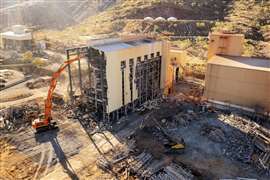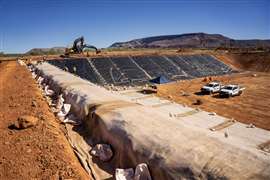Inside the Argyle Diamond Mine Closure Project
03 December 2024
PROJECT REPORT: How Liberty Industrial dismantled one of the world’s largest diamond mines in Australia’s remote Indigenous Outback.
 Site A on the Argyle Diamond Mine project. (PHOTO: Liberty Industrial)
Site A on the Argyle Diamond Mine project. (PHOTO: Liberty Industrial)
Nestled in the East Kimberley region of Western Australia, the Argyle Diamond Mine held a unique place in global mining history.
Situated on the traditional lands of the Miriuwung, Gidja, Malgnin, and Wularr people, the mine operated for 37 years, becoming a major global producer of diamonds and the largest supplier of natural-coloured diamonds, including the coveted Argyle pink and red diamonds.
Covering 50 hectares, the mine sat over 2,800 kilometres from Perth, with no major cities nearby. Self-sufficiency was paramount, with the site housing its own airport, accommodation, and operational facilities.
Mining activities began with open-pit techniques, reaching depths of 600 metres, before transitioning to underground block cave mining in 2013. Operations ceased in November 2020, marking the start of an extensive decommissioning project to restore the remote site to its natural state.
The site’s significance extended beyond its resources, with careful planning required to respect Indigenous heritage sites and culturally significant areas.
Liberty Industrial worked closely with Traditional Owner businesses throughout the project, fostering a partnership that contributed to waste management, earthworks, and mechanical maintenance services.
This collaboration included local engagement initiatives, such as Liberty’s Employment Readiness and Trainee Program, which saw two Indigenous trainees achieve Level 1 certification and secure full-time roles.
Demolition and Remediation
Following its closure, Rio Tinto commissioned Liberty Industrial to oversee the demolition of all above and below-ground infrastructure.
This encompassed major structures such as the primary, secondary and tertiary crushers, heavy media separator, diamond recovery building, and material processing facilities. Concrete footings and underground services were removed, while contaminated areas were remediated.
 Primary crusher removal. (PHOTO: Liberty Industrial)
Primary crusher removal. (PHOTO: Liberty Industrial)
Given the site’s isolation, Liberty also constructed and managed on-site landfills, categorised for general and contaminated waste.
Mechanical demolition methods dominated the project, led by Liberty’s fleet of specialised equipment, including a 200-tonne Kocurek high-reach demolition excavator and a 100-tonne Volvo 750 high-reach machine. This heavy-duty equipment allowed for safer operations by reducing personnel exposure.
 (PHOTO: Liberty Industrial)
(PHOTO: Liberty Industrial)
Induced collapse techniques were applied to high-level conveyors and trestles, with demolition strategies verified using advanced ASI Extreme Loading software.
The entire process was guided by rigorous health and safety protocols, including continuous monitoring of noise, vibration, and air quality.
A notable aspect of the remediation saw the contractor’s in-house civil remediation team remove 30,000 cubic metres of hydrocarbon-impacted soil and dismantle a 30-kilometre asbestos pipeline.
Contaminated materials were disposed of in lined containment cells designed to prevent environmental harm and facilitate future revegetation efforts.
 Containment Cell A, cell linging. (PHOTO: Liberty Industrial)
Containment Cell A, cell linging. (PHOTO: Liberty Industrial)
Sustainable Resource Management
The mine’s remote location presented significant logistical challenges for recycling. Transporting materials to Perth (2,800 km away) or Darwin (1,000 km away) was uneconomical due to the vast distances involved.
Instead, Liberty leased a section of land next to Wyndham Port, approximately two hours from the mine, to stockpile processed scrap metals and other materials.
 (PHOTO: Liberty Industrial)
(PHOTO: Liberty Industrial)
From there, 34,000 tonnes of ferrous metals and 1,000 tonnes of non-ferrous metals were shipped in three carefully scheduled consignments – each weighing an average of just over 11,000 tonnes, aligned with the port’s tidal schedule.
In addition, 800 tonnes of high-density polyethylene (HDPE) pipeline was transported to an off-site facility for reuse.
 (PHOTO: Liberty Industrial)
(PHOTO: Liberty Industrial)
By maximising material recovery and employing an on-site recycling strategy, Liberty significantly reduced landfill waste, aligning with the project’s sustainability goals.
All asbestos-containing materials were removed prior to demolition to ensure worker safety and prevent contamination of recyclable materials.
Challenges and Adaptations
One of the main challenges encountered by the project team was the works coincided with the COVID-19 pandemic, which created unprecedented logistical hurdles.
Western Australia’s strict border closures necessitated the relocation of Liberty’s management team and 80% of its workforce to the state.
Workers adhered to a three-week-on, one-week-off roster, with alternative accommodations provided to avoid disruptions caused by travel restrictions. This strategy ensured continuity and safeguarded employment for all personnel.
Adding to the complexity, the Kimberley region’s monsoonal wet season brought unpredictable and severe weather, with heavy rainfall and flooding posing risks to accessibility and scheduling.
Liberty’s team implemented contingency plans to mitigate delays, adapting operations to the region’s harsh conditions.
Completion and Legacy
The Argyle Diamond Mine closure was successfully completed on 15 April 2024, within the allocated budget and timeframe. The project’s achievements were recognised with the 2023 Global Rio Tinto Safety Award for Best Contract Partner, and the 2024 World Demolition Award for Industrial Project of the Year.
 (PHOTO: Liberty Industrial)
(PHOTO: Liberty Industrial)
Liberty Industrial’s collaborative approach, encompassing strategic planning, advanced demolition techniques, and engagement with Traditional Owners, setting a benchmark for sustainable and inclusive decommissioning projects.
Phase 2 of the closure, focusing on residual infrastructure, is anticipated in 2025, ensuring the site’s continued transformation towards environmental restoration.
CONNECT WITH THE TEAM






